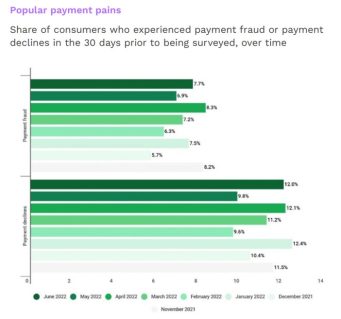To Stop Cancellations, Subscription Companies Can Fight Failed Payments and Fraud

In what’s already becoming another tumultuous economic year, direct-to-consumer (D2C) businesses may want to prioritize the prevention of two things: failed payments and fraud.
2023 has already been particularly tough for subscription companies, with 48% of businesses in the sector expecting challenges in attracting new customers over the next 12 months. That is one reason why keeping customers will be key for subscription-based businesses’ survival and may remain the sector’s modus operandi for the foreseeable future — or at least until the larger economic landscape stabilizes. As new customer acquisition can be many times more expensive than maintaining a current base, customer lifetime value will be a key metric for D2Cs to monitor during this time.
Customer lifetime value, tracking the revenue gain from a customer over their “lifetime” relationship with a company, is a key metric. Companies able to extend their customers’ subscriptions may rely on more steady, predictable revenue; moreover, repeat customers tend to buy and spend more on subsequent purchases than the average shopper. With so much long-term potential from a single existing customer, reducing the chances of customer loss through any sort of churn or friction may be subscription companies’ highest priority.
Two parts of D2C businesses’ long-term retention strategies are offering increased payment options and reducing declines, which each help provide consumers with the frictionless transactions they crave. However, with more payment options can come increased opportunities for fraud.
The February PYMNTS collaboration with Vindicia, “Subscription Commerce Tracker®,” details the rates of top payment pain points, declined payment details and fraud, for subscription customers.

One key takeaway of the data is that payment declines and payment fraud tend to grow and decrease in lockstep. Fraud rates compared monthly haven’t yet reached the level of payment declines consumers experienced in the 30 days prior to being surveyed (most recently we measured a 12% rate of payment declines compared to 7.7% of payment fraud). However, the shares of each can be significant enough to make or break subscription companies, especially those running on the tightest margins.
In commentary for PYMNTS, Wendi Lete, chief customer experience officer at Kount, details the importance for merchants of maintaining modern fraud-fighting capabilities. “[T]he capability to remain rapidly agile and responsive is vital to the success of a business. Just as consumer expectations evolve, so do the tactics of fraudulent actors. And while businesses collect massive amounts of data to pinpoint and understand these nefarious tactics, the task quickly becomes overwhelmingly time-consuming and labor-intensive. The best way to overcome this challenge is by deploying artificial intelligence and machine learning technology to help aggregate, analyze and automate the decisioning of account creation and login, purchase transactions, and post-transactional events such as chargebacks and representments.”
Subscription companies facing the current economic headwinds may consider a renewed focus on fraud, as well as payment declines, as part of their long-term retention and customer lifetime value strategy. Methods of deployment vary, and can be accomplished in-house, through a third-party partnership or some combination of both. However, in a sector where every customer counts, the only poor choice for subscription companies may be not stepping up fraud-fighting at all.
